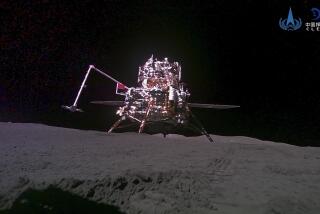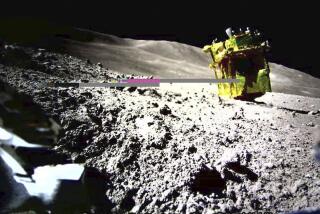Japan Hoping That Probe’s 2nd Asteroid Landing Is Fruitful
- Share via
TOKYO — A Japanese spacecraft successfully landed on the surface of a tumbling, bucking asteroid about 180 million miles from Earth, staying just long enough to fire a metal pellet into the ground and try to swallow samples of the dust and debris kicked up, Japan’s space agency said today.
If the canister did manage to capture the surface samples from the Itokawa asteroid and returns them to Earth, the mission would give scientists their first chance to examine surface materials from a celestial body that has remained largely unchanged since its formation. The surfaces of larger bodies, such as planets and moons, are altered over time, and researchers hope Itokawa will unlock clues to the creation of celestial bodies.
The landing and sample collection was a sophisticated technical feat by the Hayabusa probe, which used newly designed ion engines that need just one-tenth the fuel normally used by spacecraft. The asteroid, named for Hideo Itokawa, the father of rocket science in Japan, orbits the sun about halfway between Earth and Mars, and is just 2,300 feet long and 1,000 feet wide. Hayabusa piloted itself to the landing zone using cameras and a laser.
Launched in May 2003, Hayabusa had just two opportunities to land on the asteroid. The first attempt last weekend was initially thought to have failed. But, after examining what they described as “a somewhat mysterious sequence of events,” mission controllers concluded that Hayabusa had bounced around for 39 minutes, undamaged, on the asteroid’s surface. The probe can’t stay on the surface because of the low gravity.
Japanese officials said it was unlikely that any samples were collected during the first landing. But the subsequent takeoff allowed Project Manager Junichiro Kawaguchi to boast that Hayabusa was “the first explorer that took off from another astronomical body” far from Earth.
A success would be a badly needed boost for Japan’s troubled space program, which has been beset by several failures to get a new generation of rockets into operation even as the rival Chinese space program has launched manned missions.
But the full celebration will have to wait. The canister is not due back on Earth until 2007, when it will land in the Australian desert. Only then will it be known whether it brought back bits of Itokawa.
More to Read
Sign up for Essential California
The most important California stories and recommendations in your inbox every morning.
You may occasionally receive promotional content from the Los Angeles Times.













